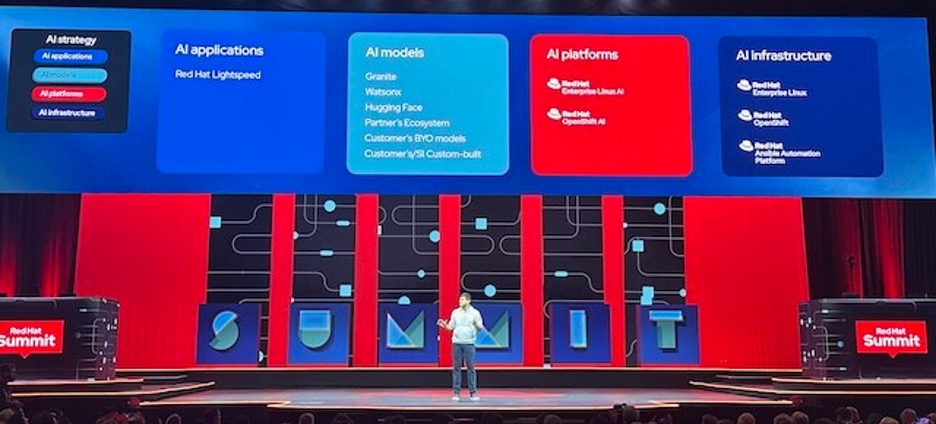
This week, I immersed myself in a number of videos from Red Hat Summit 2024. I was not able to make it to the show this year, but given my area of coverage and fond memories of my time at previous Summits while on the team at JBoss, I was excited to hear what Red Hat had to say.
Also, I want to note that I am an IBM/Red Hat alumnus, which I think gives me a certain perspective on Red Hat and open source in general, one that’s biased more towards customer outcomes over traditional open source values of freedom and transparency. I also want to be clear that I believe that IBM has done a lot for open source and that it doesn’t get the credit it deserves. More than that, I think that IBM has been smart in its stewardship of Red Hat so far. So it’s fair to say that I entered the event biased in a positive way. Yet Red Hat Summit 2024 ended up being a mixed bag for me, and I came away less excited than I expected.
My Top Observations from Red Hat Summit
Approaching these subjects as an analyst rather than a practitioner is a little strange for me. But here are some observations for Red Hat that occurred to me after tuning into the Summit a few years removed.
Red Hat made some great product announcements on the ops side. Red Hat presented a case for how its historic operating system and platform skills have translated and evolved into its vision of hybrid IT (i.e., running applications on premise, across many clouds, or at the edge). I was particularly impressed with all of the cross-product Lightspeed features, which started last year in the Ansible product but are now being deployed across the Red Hat portfolio. The best way to describe Lightspeed is the injection of generative AI features in the context of a particular product. For example, in RHEL an admin can be provided with clear explanations of command line options and syntax. Lightspeed is already in some Red Hat products, with the rest slated to arrive over the next few months.
If we abstract the benefits of Lightspeed, it comes down to this: IT ops people are in an unending war with complexity, and sometimes IT is losing. Lightspeed can help win those battles by increasing IT ops productivity through AI-based automation. More than that, the capabilities in Lightspeed illustrated a depth of knowledge on Red Hat’s part about the personas who would benefit from the technology.
I also see benefits from Image Mode and the AI capabilities in RHEL. RHEL is the foundation of all things Red Hat, and it was nice to see a spotlight on how it’s evolving with the times. So, great job by Red Hat in the IT ops space with RHEL, Ansible, and OpenShift. And clearly IT ops is an area where Red Hat parent IBM wants to do more, given its recent intent to acquire HashiCorp.
OpenShift has come a long way. Looking back on the trajectory of OpenShift, a decade ago it was more in line with contemporary developer infrastructure tools. It had a specific use and was good at it. But over time it has evolved into a complete build-run-and-manage application platform. This is impressive for a lot of reasons. First, the historic open source mindset is that of DIY types, which means they tend to like tools versus solutions. It took some guts for Red Hat to turn away from that foundation and mimic what much larger companies such as Amazon or Google were doing. Second, from discussions with many Red Hat and IBM employees, it is clear that OpenShift is a well-represented linkage between the two businesses. A lot of times tech companies struggle going all-in on a big bet. In the early days, OpenShift had many detractors. So seeing its growth and maturity 10 years later was great.
The open sourcing of AI may be ahead of its time (in a bad way). Red Hat also made a big deal out of the open sourcing of IBM’s Granite models (under very permissive Apache licensing) and its new InstructLab project for enabling AI model training and tuning. Honestly, I was not sold on InstructLab at Summit. Red Hat is positioning InstructLab as a means to contribute to open sourcing AI training and knowledge. This is a very Linux-era value proposition for AI. I believe that the technologies and times are not the same. The notion that an open LLM model where people can freely contribute is innovative, but I believe that it will be very difficult to govern and trust projects of that nature.
Also, Red Hat’s claim that forking models is slowing down AI progress does not make sense to me. AI is moving at a furious pace right now. I’d argue that what will slow things down is the idea that everyone contributes to giant models without an incentive structure like there was with Linux. Linux was all about legitimizing low-cost silicon as an alternative to proprietary compute systems. Many corporations (notably Intel and IBM) jointly invested in Linux to defeat proprietary minicomputers and Unix systems. By contrast, who’s incented to do open source AI training right now? I also struggle with the forking argument since the real value proposition for InstructLab is that partners and customers can more easily build and train their own internal models, which implies many forks.
To be clear, I am not saying it will never work or it’s a terrible idea. In fact, I am excited to learn more about the technology. What I am saying is that the AI market needs to mature more before something like this has the necessary combination of consumability, usefulness, and guardrails.
The technology has evolved, but the company hasn’t. Make no mistake: Red Hat is the steward of commercial open source, and I don’t believe there is a viable threat to that crown. But, okay, you did it—now what? I was hoping for something bolder given that the industry is pushing into new areas where Red Hat has some presence. Red Hat’s position in both the cloud and the edge, its industry solutions, and having IBM as its partner for AI are all big assets. Yet instead of painting a picture of the future, Red Hat conveyed a value proposition to attendees that boiled down to “We’re better because we’re open.” This is a newish leadership team, but it felt like they were running the old playbook. This included multiple references to “the old days” that did not reflect the current state of the market.
My Advice for Red Hat
So, now that I am looking at all of this through an analyst’s lens, what would I advise this new leadership team?
Freshen up your story! A lot of the Red Hat leaders were my colleagues when I was at Red Hat, and they have a lot of great experience and talent. But I believe Red Hat needs to think about freshening up its story for the next generation of IT ops, developers, and data scientists. Earlier Red Hat leaders did great things, but it’s time to move the message forward. This includes expanding and modernizing the open source value proposition, and potentially even redefining Red Hat’s mission. Something as simple as tuning the look and feel of the show, which seemed dark and a bit dated, would be nice. I’d also suggest increasing the messaging emphasis on how customers get value from Red Hat versus projecting Red Hat’s values.
Be clearer on the continuum from project to production. There are a lot of moving parts in the Red Hat portfolio, and it was hard to tell what was available, what was in beta, and what was an open source project. I am guessing most of the audience were drawn from the Red Hat faithful, so it may be easier for them to navigate these moving parts, but even as someone steeped in the productization process, I found myself getting lost. Maybe the company would benefit from segmenting the keynote better between present, future, and far future—and tying it all to a long-term vision. For instance, while I wasn’t sold on InstructLab, I am not that worried about it, and I’m confident that Red Hat, IBM, and the community will make it better over time. Just make it a little easier to understand the process.
Highlight what Red Hat does best. It seems that there has always been a disconnect between Red Hat corporate messaging (Open source is the way) and product messaging (We make IT a lot better). This is unfortunate, because Red Hat has never been better positioned in the market. The mainstreaming of the subscription business model, the strength of IBM as a parent (and AI collaborator), and the industrywide recognition of hybrid IT—all of these have had a major impact on the market. Convincing people that open source is okay is no longer a strategic contributor to Red Hat’s success. I’d suggest zeroing in on the best customer profiles and marketing Red Hat’s excellent (refined) value proposition to them.
Keep past decisions in the past. Having Salesforce on stage to talk about how easy it was to move from the no-cost Centos Linux distribution to RHEL was not a good look. I agree that it’s Red Hat’s prerogative to make licensing and release changes to its freely available community RHEL build. That said, those changes were a controversial decision that upset the open source faithful and forced many companies to either pay Red Hat or integrate with another freely available distribution. Again, Red Hat and IBM have every right to do this and monetize their value proposition. But that decision was in the past, and it is time to move forward. I am sure the project at Salesforce was a great sales win. But I’d advise that Red Hat saves those announcements for a sales kickoff, not the show for customers and partners. There was no need to pick at what is a sore subject.
Match the Message to the Market
Overall Red Hat continues to do a good job with staying focused on its technology, its vision of hybrid IT, and ensuring that its individual products remain relevant for years to come. I think my biggest issue is that Red Hat’s messaging, positioning, and long-term outlook need to keep up with the new market realities. The good news is that this is fixable because the foundation is strong. The bad news is that we are all in the infancy of a new wave of computing, and Red Hat’s competitors are evolving. Red Hat will need to let go of its history and reframe its own approach a bit more to stay on top of this next wave.






















































































